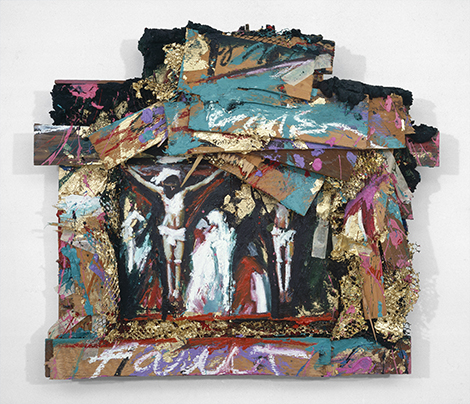To walk into the Jim Morphesis exhibition at the Pasadena Museum of California Art is to be flooded by rich, intense waves of color. The tsunami of red, blue, black and white is matched by roiling surges of thick, densely textured impasto. Only after the initial visceral impression subsides is the viewer aware that the sensual pairing of color and texture is often in the service of vanitas subjects, that is, images that remind us of the fleeting impermanence of life.
Noted art historian and curator Peter Selz titled the Morphesis retrospective “Wounds of Existence,” a phrase taken from Nietzsche’s The Birth of Tragedy (1872). Selz’s choice is appropriate because the Los Angeles painter’s works grapple not only with what the German philosopher called art’s “seductive veil of beauty,” but also the “wounds of existence” and the elusive dream of “eternal life.”
In order to address such weighty metaphysical issues, Morphesis draws on art historical symbols of great resonance: the Crucifixion, the Pieta, skulls, lacerated flesh, and roses. Each of these has served as momento mori in the Western tradition, appearing in expressive Christian art from Matthias Grunewald’s Isenheim Altarpiece to Michelangelo’s late Pietas to Rembrandt’s Carcass of Beef, as rehearsed by Chaim Soutine and Francis Bacon. Morphesis reprises art historical precedents with respect and expressive vigor, echoing the earlier iterations while making them very much his own. The artist’s use of post-industrial materials (such as day-glo pigments, rhoplex and acrylic polymers) and the calligraphic immediacy of his vital, spontaneous marks insist on the late 20th to early 21st century timing of his oeuvre.

Jim Morphesis, Destiny, 1982. Oil, magna, alkyd resin, and wood on wood panel, 68 x 64 inches. Collection of Laifun Chung and Ted Kotcheff.
Morphesis’s most recent series focuses on red roses. The artist calls the series “Time and Desire” and, indeed, the rose has represented both over time. To the Ancient Greeks and Romans, it was an attribute of Aphrodite (Venus), the goddess of love, sex and desire. To medieval Christians, the red rose represented the blood of Christian martyrs. As such, the rose was a spiritually infused memento mori. In Morphesis’ sensual rose paintings, the full, ripe blooms fill the frame, their deep red petals vacillating between bleeding wounds and swollen labia. Crystalline drops of clear liquid slide over the curved biomorphic surfaces, heightening the erotic fragility of the compositions. Roses are fully open for only a short number of hours, then the petals fall into dry, brown death, losing both their heady scent and their velvety surfaces.
The retrospective allows us to view the arc of Morphesis’ work, from early iconic abstractions, through the Crucifixion and Pieta images, to the slabs of beef and the roses. The installation reveals the through lines in both form and content: the continuity of expressive gesture articulated in diverse media, and the deepening exploration of both the “wounds of existence” and the aching reminders of our mortality.


